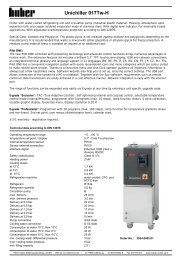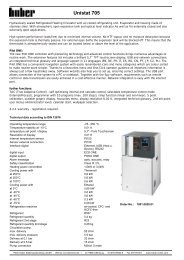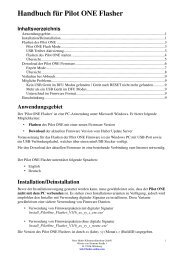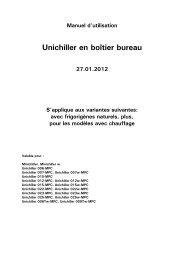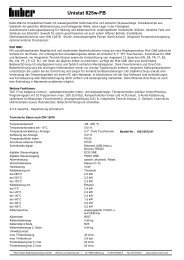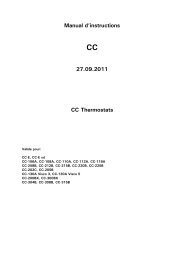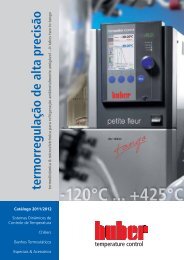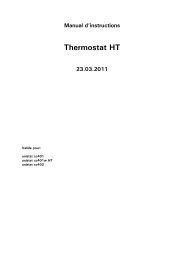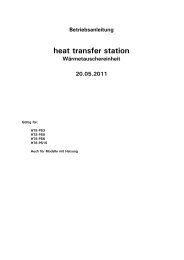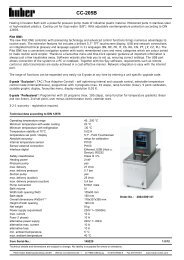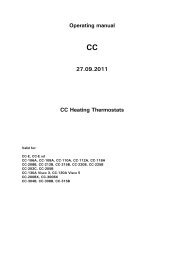Unichiller in Desktop Housing - HUBER
Unichiller in Desktop Housing - HUBER
Unichiller in Desktop Housing - HUBER
You also want an ePaper? Increase the reach of your titles
YUMPU automatically turns print PDFs into web optimized ePapers that Google loves.
Operat<strong>in</strong>g conditions<br />
Please make sure that the application and system performance is dependent upon the<br />
temperature range, viscosity, and flow rate of the thermal fluid:<br />
- Please ensure that the power supply connections are correctly dimensioned.<br />
- The temperature control device should be located so, that sufficient fresh air<br />
is available even when work<strong>in</strong>g with water cooled units.<br />
- Please note that hose connections should be compatible with the thermal<br />
fluid used and the work<strong>in</strong>g conditions.<br />
- When choos<strong>in</strong>g the thermal fluid, not only m<strong>in</strong>imal and maximum<br />
temperatures have to be complied with but also have to be suitable regard<strong>in</strong>g<br />
burn po<strong>in</strong>t, viscosity and / or freez<strong>in</strong>g. Furthermore the thermal fluid has to be<br />
compatible with all the materials used <strong>in</strong> the unit.<br />
- Pressure changes with the length of hoses (keep as short as possible).<br />
Choose as large a diameter of hoses as possible (the width of the pump<br />
connections are considered as a po<strong>in</strong>t of reference) and may negatively affect<br />
temperature control results. Flow restrictions may occur if a too narrow<br />
connector is selected for corrugated hoses.<br />
- The use of unsuitable hoses or hose connections may cause thermal and<br />
toxic <strong>in</strong>jury to personal and environment. Temperature control hoses and their<br />
connections have to be <strong>in</strong>sulated / secured aga<strong>in</strong>st contact / mechanical<br />
damage.<br />
- Non-suitable thermal fluids can negatively affect temperature control and be<br />
the cause of negative temperature results and damages. Therefore only use<br />
the thermal fluids recommended by the manufacturer and only <strong>in</strong> the <strong>in</strong>tended<br />
temperature and pressure range. The application should be located on<br />
approximately the same level or lower than the temperature control device, if<br />
temperature control is to be carried out near to the boil<strong>in</strong>g temperature of the<br />
thermal fluid. The thermal fluid should have room temperature when fill<strong>in</strong>g.<br />
Fill <strong>in</strong> the thermal fluid slowly, carefully and steadily. At the same time make<br />
sure that no thermal fluid overflows (back pressure); it is thereby necessary<br />
to wear personal protective equipment, e.g. safety goggles, thermally and<br />
chemically resistant gloves, etc.<br />
- In the case of pressure-sensitive applications, e.g. glass reactors, observe the<br />
maximum <strong>in</strong>let pressure of the temperature control device for cross section<br />
reduction or shut-off (see data sheet). Take suitable precautions (e.g.<br />
pressure limitation for temperature control devices with pressure control,<br />
bypass).<br />
- In order to avoid danger of overpressure <strong>in</strong> the system, which could damage<br />
the temperature control device or the application, the thermal fluid must<br />
always be adapted at room temperature before turn<strong>in</strong>g off and a possibly<br />
available shut-off valve must be left open (pressure compensation).<br />
- Do not k<strong>in</strong>k the hoses.<br />
- Check hoses <strong>in</strong> regular <strong>in</strong>tervals for material fatigue (e.g. cracks).<br />
11



